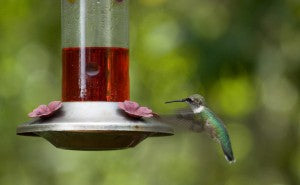These tiny creatures, most of them weighing in around 3 grams, bring huge joy to many of us in the summer. If you’re like me, then you want to continue to attract these creatures. To accomplish this, you should not only provide them an ample food source but also you should consider their shelter and nesting needs as well.
Food sources are very important to hummingbirds. With a high metabolism, the ability to flap their wings up to 53 times per second and their flight speed of 27 mph are all reasons why they eat their body weight in nectar daily and can eat up to 2,000 insects a day. That’s quite an appetite! So, let’s look at a few ways to assure they can obtain their two main food sources:
Two Food Sources:
-
Nectar
Hummingbirds have two main sources for receiving their nectar nourishment: through flowers and nectar feeders.
Flowers-Planting native flowers, shrubs and vines that are colored orange, pink or red with tubular flowers are most popular as a nectar source. Plant for constant blooming all season as this will give an uninterrupted nectar source for the hummingbirds.
Nectar Feeders– Proper care of nectar feeders is needed to assure for a healthy nectar source for the hummingbirds. Be prepared to clean the feeder every 2-3 days by discarding old nectar and disassembling the feeder. Scrub with hot water and a bottle brush to remove deadly fungus. Do not use honey in the feeder as this creates a deadly virus for hummingbirds. You can buy nectar just about anywhere you purchase your feeder. You can also make your own sugar water solution. The National Audubon Society recommends a recipe of boiling a mixture of 1 part sugar with 3 parts water. Microwave boiling isn’t recommended because it molecularly alters the nutritional value. Be sure to refrigerate any leftovers. Adding red food coloring is not recommended.
Location is important for the nectar feeders. They should be placed in a shady, open area to prevent the premature spoiling of the nectar and ease of access for our feathered friends.
2. Insects
Providing a natural environment for insects to congregate is way of assuring a food source for the hummingbirds. In a natural setting, weed patches are native habitat for insects. Obviously if you live in a subdivision or other areas where this is unacceptable, consider planting native plants that insects are attracted to, such as: purple coneflower and bee balm. They are also visually appealing, and butterflies love them as well. Trees that bear fruit are another way to attract insects. It might be practical to hang a nectar feeder from this fruit tree to further increase your chances of attracting more hummingbirds.
Nesting/Shelter
Hummingbirds build nests using soft-lined plants such as pussy willow flowers and the fluffy seeds from dandelion and thistle, among others. They take shelter in trees.
Predators
Just like any other creature, hummingbirds have predators including: housecats, preying mantis, snakes, to name a few.
Other Considerations
- Avoid Pesticides which can be ingested by the hummingbirds that eat infested insects. Instead, encourage the hummingbirds to be your natural insect control.
- Provide a water source for bathing. Just like other birds, hummingbirds like to bathe in shallow water, a water mister or a small waterfall.
- Know your region’s migratory dates for native hummingbirds. This will allow you to provide your feathered friends a welcoming nectar source after their long journey. There are several hummingbird migration maps available. Here is a website that has several such maps for the ruby-throated and the rufous hummingbird. These maps, which are updated weekly, give the dates of when the hummingbirds were spotted.



